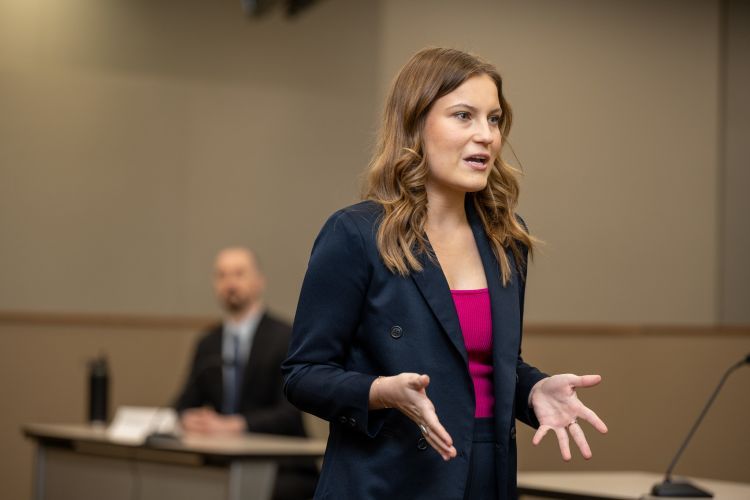Navigating the Intricacies of Test Presentations: Tips for Seamless Distribution and Engaging Disagreements
In the world of lawful process, the art of test discussion stands as an essential component of success. The intricacies integral in trial presentations require a fragile equilibrium of finesse, ability, and strategy.

Recognizing Test Goals
To effectively navigate a trial, it is essential to have a clear understanding of the goals that need to be accomplished. Before tipping into the court room, legal groups should specify their objectives and desired end results. These purposes act as directing principles throughout the test, shaping strategies and influencing decision-making procedures.
Understanding trial purposes includes a detailed analysis of the case, lawful criteria, and the client's benefits. Trial Presentations. It requires a careful evaluation of the truths, determining essential problems, and expecting potential difficulties. By establishing details and quantifiable goals, attorneys can tailor their presentations and arguments to align with the desired results
Moreover, a clear grip of trial objectives allows legal groups to prioritize evidence, witnesses, and lawful arguments effectively. It permits for the advancement of a coherent story that reverberates with the discretionary, strengthening the general situation discussion.

Organizing Evidence Properly
Having a clear understanding of test purposes lays the structure for arranging proof properly in lawful proceedings - Trial Presentations. By lining up the presentation of evidence with the preferred end results of the trial, lawful teams can strengthen their debates and enhance their persuasiveness. One crucial element of organizing evidence is classification. Grouping proof based on styles or relevance to specific lawful elements can help improve the presentation and make complex details extra digestible for the judge or jury.
One more crucial element in organizing evidence efficiently is establishing a rational flow. Presenting evidence in a consecutive and systematic way can help develop an engaging narrative that sustains the lawful arguments being made. In addition, utilizing aesthetic aids such as timelines, charts, or charts can better improve the organization of evidence and assist in clarifying intricate connections or sequences of occasions.
Moreover, guaranteeing that all proof offered is appropriate and admissible to the situation is essential. Unimportant or inadmissible proof can interfere with the toughness of the disagreement and potentially damage the trustworthiness of today party. Therefore, a precise evaluation and option procedure should be taken on to include only one of the most legally audio and impactful proof in the test presentation.
Crafting Influential Stories
Crafting engaging stories plays an essential function in presenting convincing debates throughout lawful procedures. A well-crafted narrative has the power to mesmerize the target market, evoke feelings, and ultimately guide the choice for today party. When building a narrative for a trial discussion, it is vital to establish a clear storyline that highlights crucial factors and connects them in a systematic manner. Begin by outlining the facts of the instance in a compelling manner, making sure that the sequence of occasions is very easy to adhere to. Present personalities efficiently, giving history details that helps the audience recognize their activities and motivations. In addition, integrating vibrant summaries and interesting language can bring the story to life, making it extra remarkable for the judge and jury. By weaving together proof, testimony, and lawful debates into a cohesive and influential story, legal professionals can successfully promote for their customers and boost the chance of a beneficial result in the courtroom.
Grasping Aesthetic Aids
Effective use visual aids is essential to enhancing the impact and clarity of test discussions. Aesthetic help, when utilized purposefully, have the power to simplify intricate details, strengthen essential points, and leave a lasting perception on the court and court. To grasp aesthetic aids in her comment is here trial presentations, it is critical to make sure that they are clear, concise, and directory appropriate to the arguments being made.
When incorporating visual aids, such as graphes, photos, timelines, or charts, into a test presentation, it is vital to keep them visually appealing yet expert. The visuals ought to enhance the verbal arguments, offering a visual representation of the information being reviewed without overwhelming the audience with unnecessary information.
In addition, exercising with the aesthetic help ahead of time is imperative to ensure a smooth distribution during the test. Familiarizing oneself with the web content, changes, and timings of each visual help can aid preserve the circulation of the presentation and protect against technical problems that might develop.
Delivering Impactful Closing Disagreements
A compelling closing disagreement offers as the culmination of a test discussion, enveloping the core story and convincing the court and court towards a desirable choice. Begin by detailing the major arguments that sustain your customer's position, highlighting why the evidence provided throughout the trial sustains your narrative.
Moreover, integrating emotional appeal can even more reinforce your closing argument. Ultimately, a well-crafted closing argument must leave a long-term perception, compelling the court and jury to rule in your client's support.
Conclusion
In verdict, grasping trial discussions involves understanding goals, organizing evidence, crafting stories, utilizing visual help, and supplying impactful closing arguments. By executing these methods properly, attorneys can present their instance effortlessly and make engaging arguments in the court room. It is crucial to browse the intricacies of trial presentations with precision and ability to attain success in legal proceedings.
By straightening the presentation of click here for more info evidence with the desired end results of the test, legal teams can reinforce their disagreements and boost their persuasiveness (Trial Presentations). To master visual aids in test presentations, it is crucial to make certain that they are clear, succinct, and relevant to the arguments being made
An engaging closing disagreement offers as the end result of a test presentation, encapsulating the core narrative and persuading the judge and jury towards a positive decision. Begin by describing the main debates that support your customer's placement, emphasizing why the proof presented throughout the test supports your story.In final thought, understanding trial presentations involves comprehending purposes, arranging evidence, crafting stories, using visual help, and supplying impactful closing arguments.